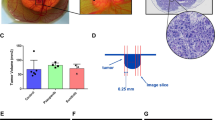Abstract
Advances in ultrasound based methods for the non-invasive assessment of the tumor microcirculation are described. Two new ultrasound approaches are highlighted. The first method relies on commercially available ultrasound contrast agents in combination with specialized nonlinear imaging sequences. Nonlinear scattering by microbubble contrast agents provides a unique intravascular signature that can be distinguished from the echoes caused by surrouning tissues. Through destruction-reperfusion experiments it is possible to use microbubble contrast agents as a tracer revealing the kinetics of tumor blood flow. The second ultrasound method for examining the microcirculation involves the use of much higher frequencies. At frequencies on the order of 50 MHz, Doppler processing allows the direct assessment of flow dynamics in realtime in arterioles as small as 15 µm. Three dimensional Doppler maps of flow patterning are presented. The strengths and weaknesses of these new methods are discussed and the potential for their use in preclinical animal drug studies, clinical drug trials, and prognostic studies is described.
Similar content being viewed by others
References
Folkman J, Merler E, Abernathy C, Williams C: Isolation of a tumor factor responsible for angiogenesis. J Experim Med 133: 275-278, 1971
Schor AM, Schor SL: Tumour angiogenesis. J Pathol 141: 385-413, 1983
Folkman J: New perspectives in clinical oncology from angiogenesis research. Eur J Cancer 32A: 2534-2539, 1996
Kerbel RS: Tumor angiogenesis: past, present and the near future. Carcinogenesis 21: 505-515, 2000
Weidner N, Semple JP, Welch WR, Folkman J: Tumor angiogenesis and metastasis-correlation in invasive breast carcinoma. N Engl J Med 324: 1-8, 1991
Gasparini G (1997) In: Bicknell R, Lewis CE, Ferrara N (eds) Tumor Angiogenesis, Oxford University Press, Oxford, pp 29-44
Klement G, Baruchel S, Rak J, Man S, Clark K, Hicklin DJ, Bohlen P, Kerbel RS: Continuous low-dose therapy with vinblastine and VEGF receptor-2 antibody induces sustained tumor regression without overt toxicity (see comments). J Clin Invest 105: R15-R24, 2000
Browder T, Butterfield CE, Kraling BM, Shi B, Marshall B, O'Reilly MS, Folkman J: Antiangiogenic scheduling of chemotherapy improves efficacy against experimental drug-resistant cancer. Cancer Res 60: 1878-1886, 2000
Jam RK, Schienger K, Hockel M, Yuan F: Quantitative angiogenesis assays: progress and problems. Nature Med 3: 1203-1208, 1997
Sandison JC: A new method for microscopic study of living growing tissues by the introduction of a transparent chamber in the rabbit's ear. Anat Rec 28: 281-287, 1924
Fan T-PD, Polverini PJ (1997) In: Bicknell R, Lewis CE, Ferrara N (eds) Tumor angiogenesis, Oxford University Press, Oxford, pp. 5-18
Muthukkaruppan VR and Auerbach R: Angiogenesis in the mouse cornea. Science 205: 1979
Gimbrone MAJ, Cotran RS, Leapman SB, Folkman J: Tumor growth and neovascularization: An experimental model using the rabbit cornea. J Natl Cancer Inst 52: 413-427, 1974
Burns P, Halliwell M, Wells P, Webb A: Ultrasonic Doppler studies of the breast. Ultrasound Med Biol 8: 127-143, 1982
Taylor KJW, Ramos I, Carter D, Morse SS, Snower D, Fortune K: Correlation of Doppler US tumor signals with neovascular morphologic features. Radiology 166: 57-62, 1988
Kedar RP, Cosgrove DO, Smith IE, Mansi JL, Bamber JC: Breast carcinoma: measurement of tumor response to primary medical therapy with color Doppler flow imaging. Radiology 190: 825-830, 1994
Burns PN, Powers JE, Hope Simpson D, Brezina A, Kolin A, Chin CT, Uhlendorf V, Fritzsch T: Harmonic power mode Doppler using microbubble contrast agents: an improved method for small vessel flow imaging. Proc IEEE UFFC 1547-1550, 1994
Mattrey RF, Steinbach GC: Ultrasound contrast agents. State of the art. Invest Radiol 26 (Suppl 1): pS5-pS11; discussion S15, 1991
Mattrey RF: The potential role of perfluorochemicals (PFCs) in diagnostic imaging. Artif Cells Blood Substit Immobil Biotechnol 22: 295-313, 1994
Mulvagh SL, DeMaria AN, Feinstein SB, Burns PN, Kaul S, Miller JG, Monaghan M, Porter TR, Shaw U, Villanueva FS: Contrast echocardiography: current and future applications. J Am Soc Echocardiogr 13: 331-342, 2000
Becher H, Burns PN Handbook of Contrast Echocardiography Springer, Berlin, (2000)
Broillet A, Puginier J, Ventrone R, Schneider M: Assessment of myocardial perfusion by intermittent harmonic power Doppler using SonoVue, a new ultrasound contrast agent. Invest Radiol 33: 209-215, 1998
Wilson SR, Burns PN, Muradali D, Wilson JA, Lai X: Harmonic hepatic US with microbubble contrast agent: initial experience showing improved characterization of hemangioma, hepatocellular carcinoma, and metastasis. Radiology 215: 153-161, 2000
Burns PN, Wilson SR, Simpson DH: Pulse inversion imaging of liver blood flow: improved method for characterizing focal masses with microbubble contrast. Invest Radiol 35: 58-71, 2000
Tiemann K, Lohmeier S, Kuntz S, Koster J, Burns PN, Porter TR, Becher H: Real-time contrast echo assessment of myocardial perfusion at low emission power: first experimental and clinical results using power pulse inversion imaging. Echocardiography 16: 799-809, 1999
Foster FS, Pavlin CJ, Harasiewicz KA, Christopher DA, Tumbull DH: Advances in ultrasound biomicroscopy. J Ultrasound Med Biol 26: 1-27, 2000
Ferrara KW, Zagar BG, Sokil-Melgar JB, Silverman RH, Aslanidis IM: Estimation of blood velocities with high-frequency ultrasound. IEEE Trans Ultrason Ferroelect Freq Contr 43: 149-157, 1996
Berson M, Patat F, Wang ZQ, Besse D, Pourcelot L: Very high-frequency pulsed Doppler apparatus. Ultrasound Med Biol 15: 121-131, 1989
Christopher DA, Burns PN, Foster FS: High frequency continuous wave Doppler ultrasound system for the detection of blood flow in the microcirculation. Ultrasound Med Biol 22: 1196-1203, 1996
Christopher DA, Starkoski BG, Burns PN, Foster FS: High frequency pulsed Doppler ultrasound system for detecting and mapping blood flow in the microcirculation. Ultrasound Med Biol 23: 997-1015, 1997
Kruse D, Fornaris J, Silverman R, Coleman D, Ferrara KW: A swept-scanning mode for estimation of blood velocities in the microvasculature. IEEE Trans Ultrason Ferroelect Freq Contr 45: 1437-1440, 1998
Goertz DE, Christopher DA, Yu JL, Kerbel RS, Burns PN, Foster FS: High frequency colour flow imaging of the microcirculation. Ultrasound Med Biol 26: 63-71, 2000
Author information
Authors and Affiliations
Rights and permissions
About this article
Cite this article
Stuart Foster, F., Burns, P.N., Simpson, D.H. et al. Ultrasound for the Visualization and Quantification of Tumor Microcirculation. Cancer Metastasis Rev 19, 131–138 (2000). https://doi.org/10.1023/A:1026541510549
Issue Date:
DOI: https://doi.org/10.1023/A:1026541510549




